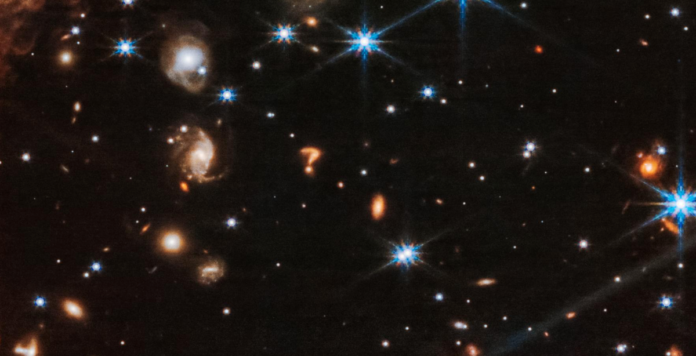Nasa ‘s James Webb space telescope has captured the most detailed image yet of a star system about 1,470 light years away – with one strange cosmic object shaped like a ‘question mark’ in its background. The star system, dubbed Herbig-Haro 46/47, was captured by the Webb telescope’s powerful infrared cameras and consists of two young stars pulled to each other by gravity as they spin. An image reveals the stars as buried deeply, appearing as an orange-white splotch, surrounded by a disk of gas and dust that continued to add to their mass. ‘Herbig-Haro 46/47 is an important object to study because it is relatively young – only a few thousand years old,’ Nasa noted in a statement. The tightly bound pair of actively forming stars have two-sided orange lobes created by earlier ejections from these stars. Since stars typically take millions of years to form, researchers said the young ones spotted in the image can give astronomers more insight into how stars gather mass over time. ‘Over millions of years, the stars in Herbig-Haro 46/47 will fully form – clearing the scene,’ Nasa said. Understanding the evolution of this pair of stars could help model how our own Sun, a low-mass star, formed, scientists said. The image also captured an astronomical feature in the background of these stars that bears an uncanny similarity to a question mark. Scientists speculate this cosmic entity to be a distant galaxy , or two galaxies interacting with each other. They suspect it could be one big galaxy distorting the cosmic cloud and gas of the other, forming a shape similar to a question mark. The red colour of the question mark-shaped object in the image suggested it is much more distant than the stars, far away from our Milky Way galaxy, and it might be the first time astronomers have spotted the entity. ‘This may be the first time we’ve seen this particular object. Additional follow-up would be required to figure out what it is with any certainty. Webb is showing us many new, distant galaxies – so there’s a lot of new science to be done!’ the US’s Space Telescope Science Institute, which manages Webb’s science operations, told Space.com.
Webb telescope spots strange galaxy that looks like a giant cosmic ‘question mark’
Sourceindependent.co.uk
RELATED ARTICLES


